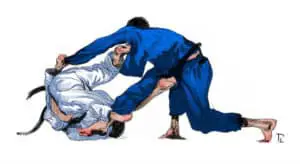You are thinking of signing up to your first BJJ class. But you are not sure if you have enough time to train or if you are in good enough condition to survive a whole BJJ class. In this article we will show how long a BJJ class is and what is involved. So when you turn up to your first class you will be prepared and ready to enjoy BJJ.
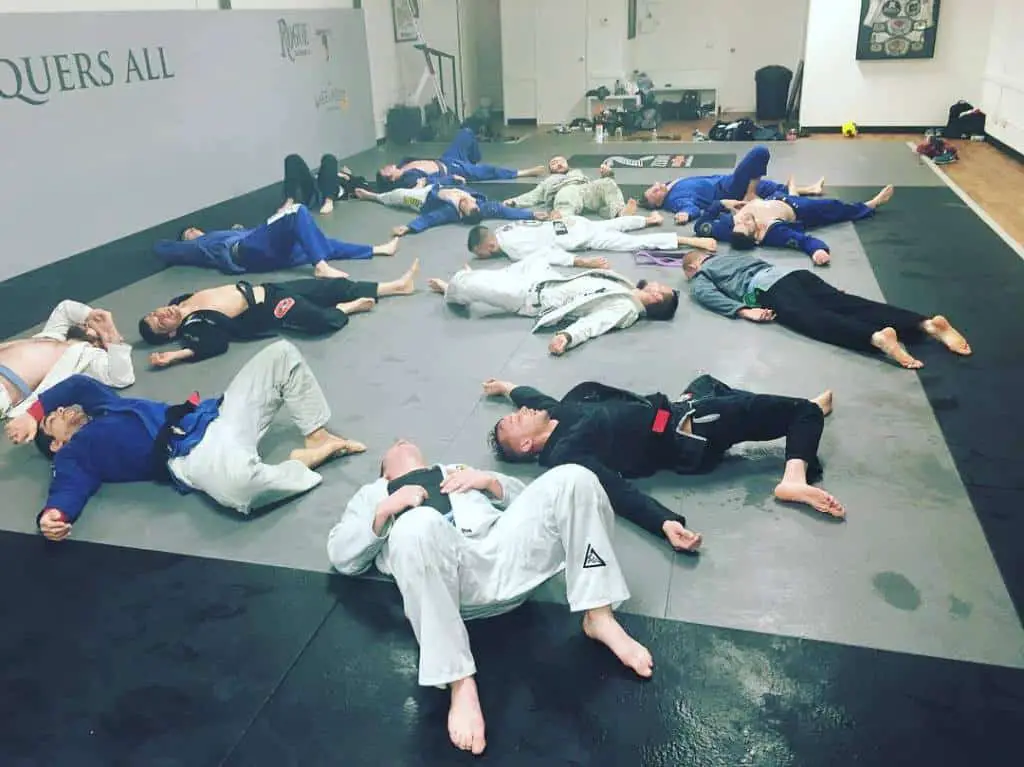
How long is a BJJ class? A BJJ class is usually between 60-120 mins. With the average class lasting 90 mins. BJJ classes tend to follow the same structure: a 15-30 mins warm-up, 30-60 mins technical instruction (drilling) and then concluding with 15-30mins of sparring (rolling). Some gyms will also include a warm down and stretching session post training.
Why Is A BJJ Class 60-120 Mins Long?
BJJ is physically intensive exercise. You need to prepare your body to handle the strenuous workout. BJJ places stress on a variety of muscles including abs, back, shoulders and neck. This is why an extensive warmup is needed to get your body ready to complete your BJJ.
BJJ is difficult to learn and their are so many different techniques that an athlete needs to know. You could spend your entire life trying to learn every technique and set up in BJJ. Due to the depth and complexity of BJJ a large portion of time needs to be dedicated to learning new techniques and practicing techniques you have previously learned. If you don’t continually practice techniques you have previously learned you quickly forget and they won’t be encoded in your muscle memory.
BJJ is an effective martial art because it is stress tested and only techniques that work under resistance are kept in the curriculum. Stress testing in BJJ takes the form of sparring. Performing BJJ techniques under resistance is very difficult and challenging. An athlete needs to spend a lot of timing practicing sparring so that he can perform his technique effortlessly against a resisting opponent. This is why a lot time needs to be assigned to sparring in BJJ.
Warmup

A warmup in BJJ is similar to a warmup in other sports where you perform basic exercises and stretch your body to get blood flowing and loosen your muscles. The purpose of the warmup in BJJ is to reduce the risk of injury and to help athletes perform the movements effectively.
Warmups vary depending on which BJJ gym you train at but they typically last between 15-30 mins and look similar to this BJJ warmup example:
- Jogging around the mat – high knees, skipping, rotating shoulders
- Basic gymnastic movements – forward rolls, shoulder rolls, handstand, cartwheel, head spring
- Animal movements – bear crawl, crab walk
- BJJ specific movements – shooting takedowns, hip escapes, granby rolls, reverse hip escapes
- Calisthenics – pushups, situps, burpees
- Stretching – neck, hamstrings, shoulders, hips, groin
Technical Instruction (Drilling)
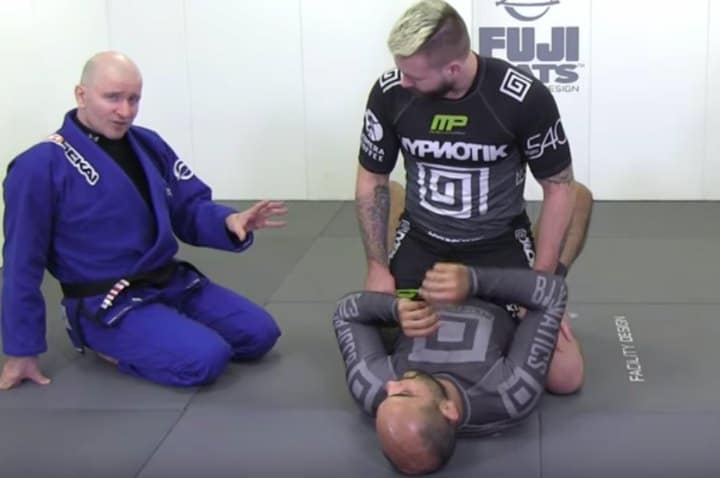
Technical instruction also known as drilling is the major part of a typical BJJ class. This is where you will learn new BJJ techniques and will practice them with a partner. Drilling usually lasts between 30-60 mins. Drilling typically looks the same at all BJJ schools. The coach will get everyone to gather around in a circle and choose a student as his demonstration partner. The coach will then perform a technique multiple times so everyone can see it. The coach will explain the purpose of the technique and why and how it works. Students are able to ask questions about the technique.
Once everyone understands the technique you will partner up and practice the technique you were just shown on one another without resisting. The coach will walk around the room helping students out, ensuring everyone is performing the technique correctly. After you have spent some time practicing the movement the coach will stop the class and get everyone to gather around as they demonstrate another technique. This process will continue until the drilling segment of the class finishes. Typically a coach will demonstrate 3-6 techniques per class and usually these techniques will be related to each other.
BJJ follows the before you can walk you need to crawl mantra. Drilling is the crawl phase where athletes learn new techniques by performing them on a non-resisting partner first and then once they are able to do that they then move on to performing the techniques against a resisting partner which is known as rolling. We will speak about drillinh in the next section.
Sparring (Rolling)
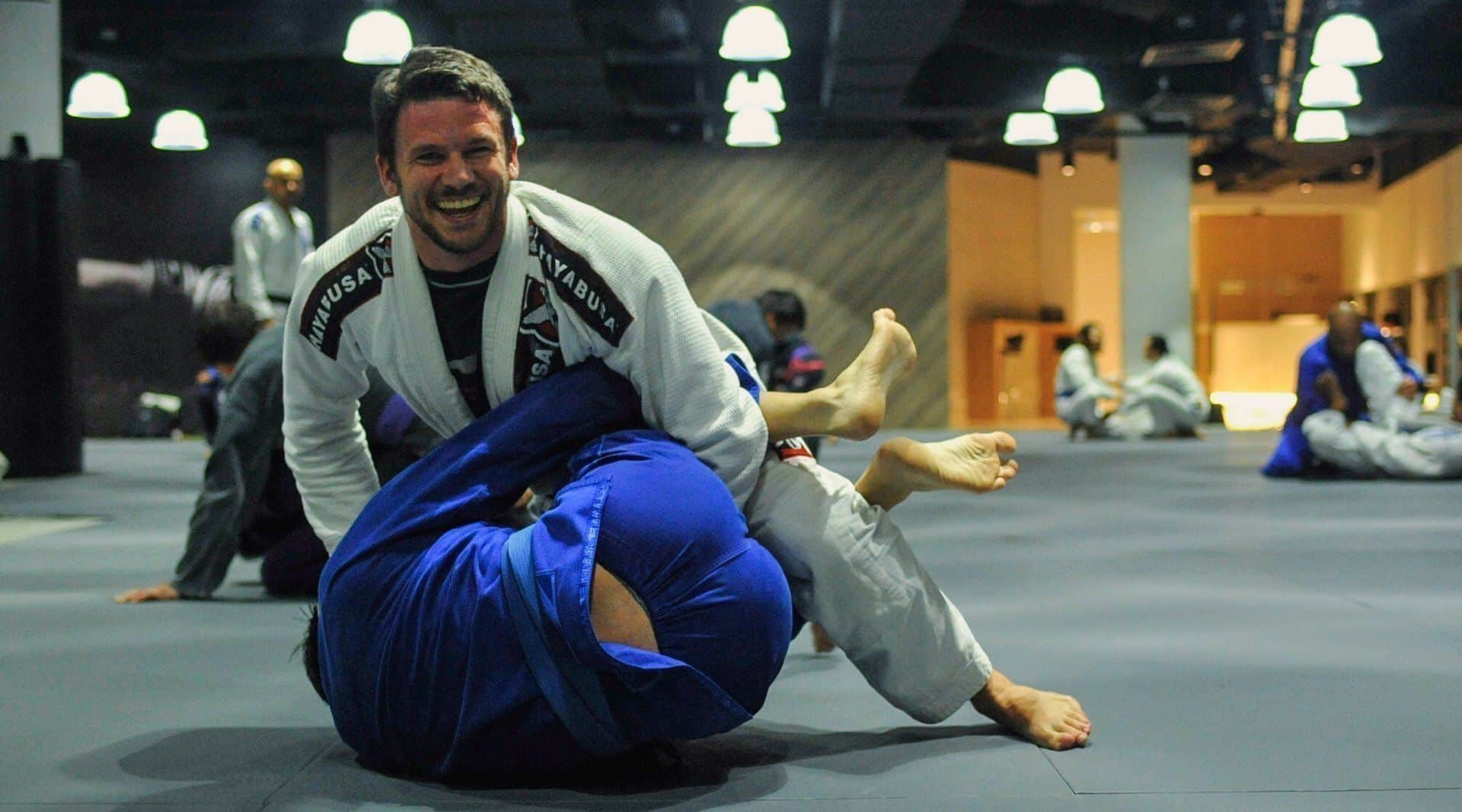
Sparring which is known as rolling in BJJ is where you get to try out the techniques you learned against resistance. Sparring typically lasts 15-30 mins with each round being between 4-6 mins. How sparring works is your coach will set a timer and you will find a partner and when the bell goes you will have a mock match against your training partner. You will attempt to control and submit your training partner following the rules of BJJ and your partner will do the same. Even though sparring is similar to a mock match the goal isn’t to win. The goal in rolling is to improve your BJJ skill by improving your ability to execute your technique while facing resistance. In a typical BJJ class you will do 4-6 rounds of rolling
Rolling is great fun and what most people look forward to in BJJ. Remember if you are new to BJJ to take it easy and to focus on performing the techniques correctly. Rolling is exhausting and there is potential for injury so slow it down, use your technique and remember to tap early.
Types Of Sparring
There are a number of variations of sparring that differ from regular sparring. We will explain what they are and their purpose.
Positional
In positional sparring you are only allowed to engage your opponent in one specific position and when you leave this position the sparring finishes and you reset. For example you may choose a position such as closed guard. A typical positional sparring round would involve the person in the closed guard attempting to pass his opponent’s guard while the person on bottom would be attempting to submit or sweep his opponent from closed guard. If one of the athletes is successful the two athletes would reset in closed guard and continue sparring.
The purpose of positional sparring is to force athletes to develop competence in key positions in BJJ. In regular rolling you may only find yourself in particular positions every now and then. So it can be difficult to improve a position when you don’t have many opportunities to practice it. Positional sparring solves this problem as you will be able to get lots of repetitions in specific positions.
Positional sparring is most effective it when you use it to practice positions which you are weak in. This can be humbling and frustrating as at first you may ineffective against people you usually get the better of. However it is critical to put yourself in uncomfortable positions if you want to improve your BJJ and become a well rounded practitioner.
Technical
Technical sparring, also known as flow rolling is where you spar against your opponent at a very flow intensity usually between 30-50%. In technical sparring you want to focus purely on using BJJ techniques and as little athleticism as possible. During technical sparring you want flow from one position to the other there shouldn’t be any stalemates or pauses. High level technical sparring should look like a dance where athletes are trading techniques.
The purpose of technical sparring is to refine your technique and to make technical breakthroughs through exploration. Technical sparring allows you to practice BJJ in a calm and relaxed setting where you can still test your BJJ against some resistance. This calm atmosphere allows you to focus purely on improving your technique instead of competing against your training partners. The reduction in use of muscle can show you what areas of your technique are lacking and need improving.
In technical sparring you are encouraged to try things out. This can lead you to discovery new techniques and positions which you can add to your game. Resulting in you becoming a more effective and well rounded BJJ practioner.
Technical sparring can also be used as an effective BJJ specific warmup. Technical sparring can prepare your body for BJJ training by allowing you to practice BJJ techniques in a slow and controlled way.
Technical sparring may sound easy but it is very difficult to perform well. A lot of people don’t know enough techniques to be able to effortlessly transition between them for a whole round. Also many people rely on athleticism to complete techniques and their technical flaws are exposed when technical sparring. Finally many people’s egos get in the way, they start off rolling at a light intensity but by the end of the round they have abandoned technical sparring and are rolling at a high intensity.
Here is a great video of Marcelo Garcia and Ryan Hall Flow Rolling
Competition
Competition sparring is sparring that is used to prepare an athlete for an upcoming competition. The way competition sparring differs from the regular sparring is the intensity. Competition sparring usually takes place at 85-95% intensity to mimic the intensity of BJJ competitions. Competition sparring also mimics the rules of the competition that the athlete is preparing. For example if the athlete is competing in a 10 min match with heelhooks allowed then the athlete will spar under these conditions. Competition sparring isn’t a time to try out new techniques it is a time to practice your best techniques and focus on winning.
Shark Tank
A shark tank is a type of sparring drill where one athlete will continuously spar against new fresh opponents within a single round. For example athlete A will be sparring and every time he is submitted or submits his opponent a new opponent will immediately start sparring with athlete A. This process will continue until the sparring round ends. The athletes who aren’t sparring will be resting ensuring that athlete A faces fresh opponents. The shark tank drill is used to develop an athlete’s conditioning and mental toughness.
It can be very challenging when you are exhausted after facing multiple opponents only to have a completely fresh fresh opponent jump on you and try to squeeze your head off. During a shark tank you have to dig deep and find that extra energy this is why it is a great conditioning drill.
Types Of BJJ Classes
A lot of BJJ gyms offer different classes to suit different students’ needs. We will explore what these different classes are and their purpose.
Beginner’s
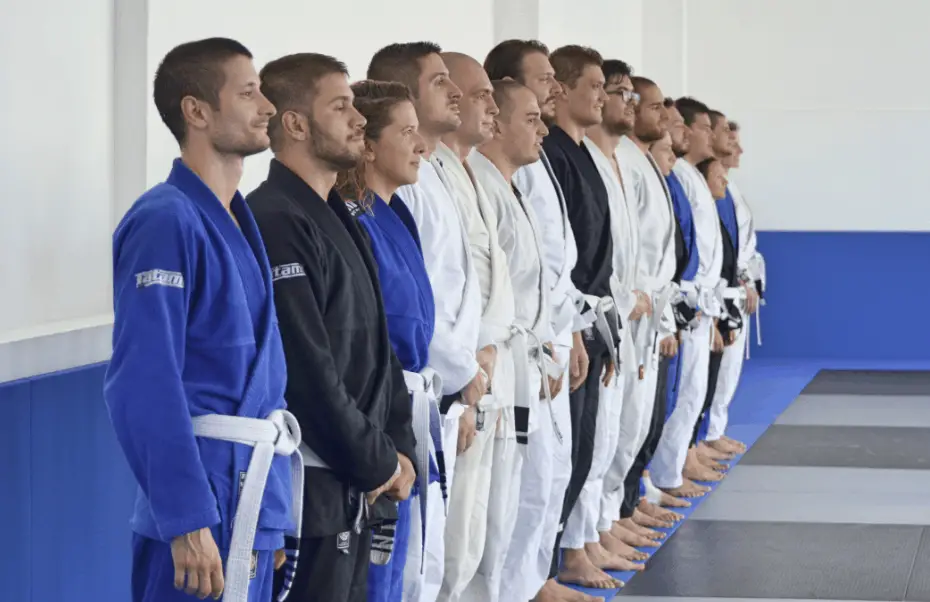
A beginner’s class focuses on teaching the basics and fundamentals of BJJ. A beginner’s class goal is to teach white belts the skills they need to progress to blue belt. This class will focus on the most common techniques used in BJJ such as side control/mount escapes, establishing guard, armbar from guard, taking and escaping the back and finishing from the back. Beginner’s classes will often have limited sparring and if they do have sparring it will often be positional. Beginner’s classes can be beneficial for all BJJ levels as one can never be too good at the fundamentals.
Beginner’s classes are usually a little less intimidating then open classes as typically you will be training alongside other white belts who are new to BJJ. However the downside to this is your white belt partners will be of limited help if you are having a problem with a certain technique and the coach is busy helping someone else.
Advanced
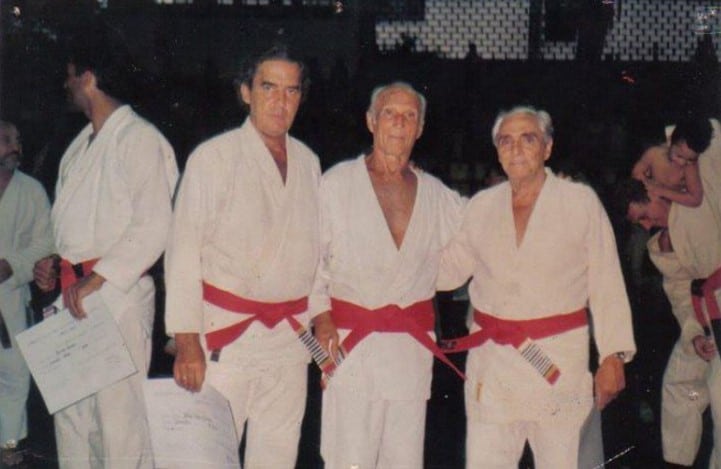
Advanced BJJ classes are classes which focus on teaching advanced techniques in BJJ. Advanced classes are typically restricted to purple belts and above, sometimes blue belts will be allowed to attend. Advanced classes will typically feature more rolling and positional sparring. Advanced classes are not a feature at all BJJ gyms and they do not really differ much from a regular class. Advanced classes will have a higher concentration of upper belts, some of the techniques may be harder to grasp and there will be more rolling.
Competition
Competition classes as the name suggests are designed to prepare an athlete for competition. Competition classes are less focused on teaching athletes new techniques and are more focused on improving an athletes conditioning and getting them ready for the intensity of competition. Competition classes will often have a longer and much more intense warmup than a regular class. The warmup will be used to build an athlete’s cardio and get them tired before training begins. The drilling phase of a competition class is usually shorter than a regular class and the sparring phase is usually longer. During competition classes you will see lots of positional sparring and shark tank drills.
Open Mat

An open mat is a BJJ class which has no formal instruction. Athletes can go there and train as they wish whether that is do conditioning, drill or roll. At open mats most people choose to just roll. The coach will set a timer and you can roll as much or as little as you want. Open mats don’t have a defined start and finishing point. Athletes typically come and go as they please within the time allotted by the coach. Open mats are more laid back and social than class with people sitting out rounds chatting. Open mats can be a great way to get some extra sparring rounds in, learn some new techniques which your training partners may show you and make some new friends.
Conclusion
A BJJ class lasts between 60-120 mins and follows a typical structure of warmup (15-30 mins), drilling (30-60 mins) and sparring (15-30 mins). There are different types of BJJ sparring and classes which all should be incorporated into your training if you want to become a well rounded BJJ practitioner.
I hope this article has sufficiently informed on the length of a BJJ class and let you know what type of training you can expect to partake in during your first class. Good luck with your training and your BJJ journey.
